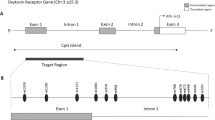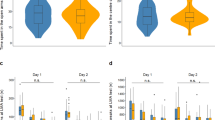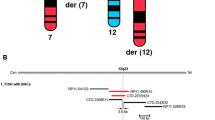Abstract
Prader–Willi syndrome (PWS) is a multisystem, contiguous gene disorder caused by an absence of paternally expressed genes within the 15q11.2-q13 region via one of the three main genetic mechanisms: deletion of the paternally inherited 15q11.2-q13 region, maternal uniparental disomy and imprinting defect. The deletion class is typically subdivided into Type 1 and Type 2 based on their proximal breakpoints (BP1–BP3 and BP2–BP3, respectively). Despite PWS being a well-characterized genetic disorder the role of the specific genes contributing to various aspects of the phenotype are not well understood. Methylation-specific multiplex ligation-dependent probe amplification (MS-MLPA) is a recently developed technique that detects copy number changes and aberrant DNA methylation. In this study, we initially applied MS-MLPA to elucidate the deletion subtypes of 88 subjects. In our cohort, 32 had a Type 1 and 49 had a Type 2 deletion. The remaining seven subjects had unique or atypical deletions that were either smaller (n=5) or larger (n=2) than typically described and were further characterized by array-based comparative genome hybridization. In two subjects both the PWS region (15q11.2) and the newly described 15q13.3 microdeletion syndrome region were deleted. The subjects with a unique or an atypical deletion revealed distinct phenotypic features. In conclusion, unique or atypical deletions were found in ∼8% of the deletion subjects with PWS in our cohort. These novel deletions provide further insight into the potential role of several of the genes within the 15q11.2 and the 15q13.3 regions.
Similar content being viewed by others
Log in or create a free account to read this content
Gain free access to this article, as well as selected content from this journal and more on nature.com
or
References
Cassidy SB, Driscoll DJ : Prader-Willi syndrome. Eur J Hum Genet 2009; 17: 3–13.
Dykens EM, Cassidy SB, King BH : Maladaptive behavior differences in Prader-Willi syndrome due to paternal deletion versus maternal uniparental disomy. Am J Ment Retard 1999; 104: 67–77.
Horsthemke B, Buiting K : Genomic imprinting and imprinting defects in humans. Adv Genet 2008; 61: 225–246.
Nicholls RD, Knepper JL : Genome organization, function, and imprinting in Prader-Willi and Angelman syndromes. Annu Rev Genomics Hum Genet 2001; 2: 153–175.
Christian SL, Bhatt NK, Martin SA et al: Integrated YAC contig map of the Prader-Willi/Angelman region on chromosome 15q11-q13 with average STS spacing of 35 kb. Genome Res 1998; 8: 146–157.
Butler MG, Fischer W, Kibiryeva N, Bittel DC : Array comparative genomic hybridization (aCGH) analysis in Prader-Willi syndrome. Am J Med Genet A 2008; 146: 854–860.
Sahoo T, Bacino CA, German JR et al: Identification of novel deletions of 15q11q13 in Angelman syndrome by array-CGH: molecular characterization and genotype-phenotype correlations. Eur J Hum Genet 2007; 15: 943–949.
Wang NJ, Liu D, Parokonny AS, Schanen NC : High-resolution molecular characterization of 15q11-q13 rearrangements by array comparative genomic hybridization (array CGH) with detection of gene dosage. Am J Hum Genet 2004; 75: 267–281.
Sahoo T, Shaw CA, Young AS et al: Array-based comparative genomic hybridization analysis of recurrent chromosome 15q rearrangements. Am J Med Genet A 2005; 139: 106–113.
Buiting K, Horsthemke B, Prader-Willi Syndrome Association: Molecular Genetic Findings in Prader-Willi Syndrome. in Merlin G Butler, PDKL, Barbara Y Whitman (eds): Management of Prader-Willi Syndrome, 3rd edn, Birkhäuser: Springer, 2006, pp 58–73.
Mignon-Ravix C, Depetris D, Luciani JJ et al: Recurrent rearrangements in the proximal 15q11-q14 region: a new breakpoint cluster specific to unbalanced translocations. Eur J Hum Genet 2007; 15: 432–440.
Duker AL, Ballif BC, Bawle EV et al: Paternally inherited microdeletion at 15q11.2 confirms a significant role for the SNORD116 C/D box snoRNA cluster in Prader-Willi syndrome. Eur J Hum Genet 2010; 18: 1196–1201.
Chai JH, Locke DP, Greally JM et al: Identification of four highly conserved genes between breakpoint hotspots BP1 and BP2 of the Prader-Willi/Angelman syndromes deletion region that have undergone evolutionary transposition mediated by flanking duplicons. Am J Hum Genet 2003; 73: 898–925.
Burnside RD, Pasion R, Mikhail FM et al: Microdeletion/microduplication of proximal 15q11.2 between BP1 and BP2: a susceptibility region for neurological dysfunction including developmental and language delay. Hum Genet 2011.
Butler MG, Bittel DC, Kibiryeva N, Talebizadeh Z, Thompson T : Behavioral differences among subjects with Prader-Willi syndrome and type I or type II deletion and maternal disomy. Pediatrics 2004; 113: 565–573.
Dykens EM, Roof E : Behavior in Prader-Willi syndrome: relationship to genetic subtypes and age. J Child Psychol Psychiatry 2008; 49: 1001–1008.
Milner KM, Craig EE, Thompson RJ et al: Prader-Willi syndrome: intellectual abilities and behavioural features by genetic subtype. J Child Psychol Psychiatry 2005; 46: 1089–1096.
Procter M, Chou LS, Tang W, Jama M, Mao R : Molecular diagnosis of Prader-Willi and Angelman syndromes by methylation-specific melting analysis and methylation-specific multiplex ligation-dependent probe amplification. Clin Chem 2006; 52: 1276–1283.
Bittel DC, Kibiryeva N, Butler MG : Methylation-specific multiplex ligation-dependent probe amplification analysis of subjects with chromosome 15 abnormalities. Genet Test 2007; 11: 467–475.
Boyar FZ, Whitney MM, Lossie AC et al: A family with a grand-maternally derived interstitial duplication of proximal 15q. Clin Genet 2001; 60: 421–430.
Nellhaus G : Head circumference from birth to eighteen years. Practical composite international and interracial graphs. Pediatrics 1968; 41: 106–114.
Butler MG, Sturich J, Myers SE, Gold JA, Kimonis V, Driscoll DJ : Is gestation in Prader-Willi syndrome affected by the genetic subtype? J Assist Reprod Genet 2009; 26: 461–466.
Miller JL, Lynn CH, Driscoll DC et al: Nutritional Phases in Prader-Willi Syndrome. Am J Med Genet 2011; in: press.
Christian SL, Fantes JA, Mewborn SK, Huang B, Ledbetter DH : Large genomic duplicons map to sites of instability in the Prader-Willi/Angelman syndrome chromosome region (15q11-q13). Hum Mol Genet 1999; 8: 1025–1037.
Donlon TA, Lalande M, Wyman A, Bruns G, Latt SA : Isolation of molecular probes associated with the chromosome 15 instability in the Prader-Willi syndrome. Proc Natl Acad Sci USA 1986; 83: 4408–4412.
Spritz RA, Bailin T, Nicholls RD et al: Hypopigmentation in the Prader-Willi syndrome correlates with P gene deletion but not with haplotype of the hemizygous P allele. Am J Med Genet 1997; 71: 57–62.
Enna SJ, McCarson KE : The role of GABA in the mediation and perception of pain. Adv Pharmacol 2006; 54: 1–27.
Miller J, Kranzler J, Liu Y et al: Neurocognitive findings in Prader-Willi syndrome and early-onset morbid obesity. J Pediatr 2006; 149: 192–198.
Agulhon C, Abitbol M, Bertrand D, Malafosse A : Localization of mRNA for CHRNA7 in human fetal brain. Neuroreport 1999; 10: 2223–2227.
Helbig I, Mefford HC, Sharp AJ et al: 15q13.3 microdeletions increase risk of idiopathic generalized epilepsy. Nat Genet 2009; 41: 160–162.
van Bon BW, Mefford HC, Menten B et al: Further delineation of the 15q13 microdeletion and duplication syndromes: a clinical spectrum varying from non-pathogenic to a severe outcome. J Med Genet 2009; 46: 511–523.
Sharp AJ, Mefford HC, Li K et al: A recurrent 15q13.3 microdeletion syndrome associated with mental retardation and seizures. Nat Genet 2008; 40: 322–328.
Ben-Shachar S, Lanpher B, German JR et al: Microdeletion 15q13.3: a locus with incomplete penetrance for autism, mental retardation, and psychiatric disorders. J Med Genet 2009; 46: 382–388.
Girirajan S, Eichler EE : Phenotypic variability and genetic susceptibility to genomic disorders. Hum Mol Genet 2010; 19: R176–R187.
Antonacci F, Kidd JM, Marques-Bonet T et al: A large and complex structural polymorphism at 16p12.1 underlies microdeletion disease risk. Nat Genet 2010; 42: 745–750.
Acknowledgements
We gratefully acknowledge the participation and provision of information provided by the families at the University of Florida and in the Rare Disease Natural History Study. We thank Krista Garner and Christy Lynn for their expert assistance in clinical assessments, Drs Karin Buiting and Bernhard Horsthemke for sharing their MLPA protocol, and Dr Robert Nicholls for critical comments on parts of this manuscript. This work was supported in part by the Hayward Foundation (DJD), the National Institutes of Health (NIH) U54 HD061222 and RR019478 (SJK; JLM; ALB; TXS; DJD), and the NIH/National Center for Research Resources CTSA Grant 1UL 1RR029890. SJK is supported in part by 2007 NARSAD young investigator award, 2008 PWSA (USA) Research Award, NIH R03MH083673 and NIH K23MH082883 awards.
Author information
Authors and Affiliations
Corresponding author
Ethics declarations
Competing interests
The authors declare no conflict of interest.
Additional information
Supplementary Information accompanies the paper on European Journal of Human Genetics website
Rights and permissions
About this article
Cite this article
Kim, SJ., Miller, J., Kuipers, P. et al. Unique and atypical deletions in Prader–Willi syndrome reveal distinct phenotypes. Eur J Hum Genet 20, 283–290 (2012). https://doi.org/10.1038/ejhg.2011.187
Received:
Revised:
Accepted:
Published:
Issue date:
DOI: https://doi.org/10.1038/ejhg.2011.187
Keywords
This article is cited by
-
Genetic subtypes and phenotypic characteristics of 110 patients with Prader-Willi syndrome
Italian Journal of Pediatrics (2022)
-
Recommendations for the diagnosis and management of childhood Prader-Willi syndrome in China
Orphanet Journal of Rare Diseases (2022)
-
First report of two successive deletions on chromosome 15q13 cytogenetic bands in a boy and girl: additional data to 15q13.3 syndrome with a report of high IQ patient
Molecular Cytogenetics (2019)
-
Gastro-oesophageal reflux - an important causative factor of severe tooth wear in Prader-Willi syndrome?
Orphanet Journal of Rare Diseases (2018)
-
Diagnoses and characteristics of autism spectrum disorders in children with Prader-Willi syndrome
Journal of Neurodevelopmental Disorders (2017)



